Yoga Exercises for Flexibility

Yoga Exercises for Flexibility
Yoga is a discipline that enhances physical, mental, and spiritual well-being. One of its primary physical benefits is increased flexibility. Flexibility is crucial for overall fitness, reducing the risk of injury, and improving posture. Following are some some of the yoga exercises for flexibility:
1. Downward-Facing Dog (Adho Mukha Svanasana)
Downward-Facing Dog (Adho Mukha Svanasana) stretches the hamstrings, calves, and shoulders, while strengthening the arms and legs. It also helps to lengthen the spine and improve overall body flexibility.
Steps:
- Begin on your hands and knees.
- Extend your fingers wide and apply pressure through your knuckles and palms.
- Lift your knees off the ground and tuck your toes in.
- Straighten your legs as much as possible while keeping your spine long.
- Hold the pose for several breaths.
Benefits:
- Stretches and lengthens the spine.
- Opens up the shoulders and chest.
- Improves blood flow to the brain.
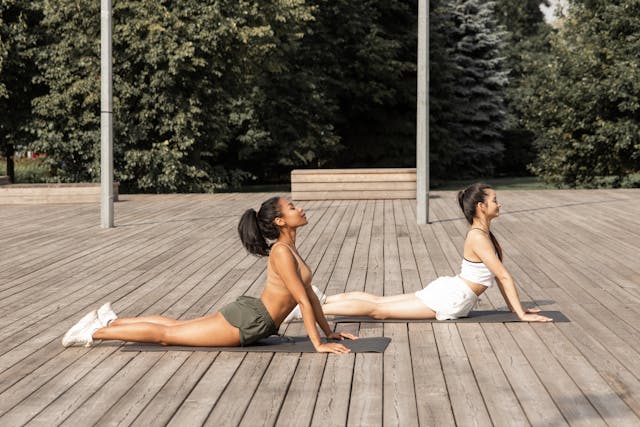
2. Cobra Pose (Bhujangasana)
Cobra Pose stretches the muscles in the chest, shoulders, and abdomen. It enhances posture and strengthens the spine.
Steps:
- Lie on your stomach with your legs extended and tops of your feet on the floor.
- Place your hands under your shoulders.
- Press into your hands and lift your chest off the floor.
- Keep your elbows slightly bent and shoulders away from your ears.
- Hold the pose for several breaths.
Benefits:
- Stretches the chest and lungs.
- Strengthens the spine.
- Alleviates stress and fatigue.
Also Read: Yoga Exercises For Weight Loss
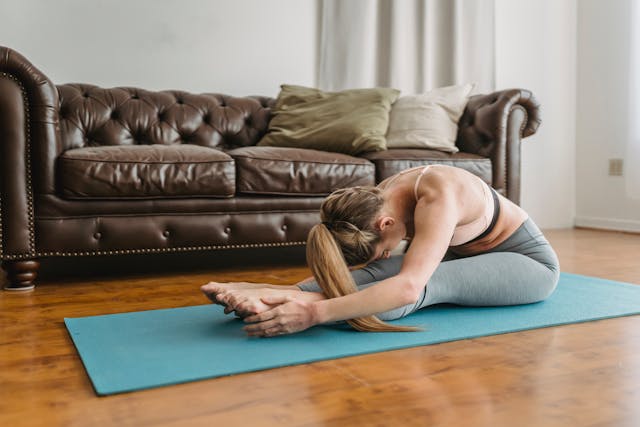
3. Seated Forward Bend (Paschimottanasana)
Seated Forward Bend (Paschimottanasana) is a yoga exercises for flexibility that deeply stretches the hamstrings, lower back, and spine. It also calms the mind, reduces stress, and improves digestion by stimulating the abdominal organs.
Steps:
- Sit on the floor with your legs out in the direction of you.
- Flex your feet and engage your thigh muscles.
- Inhale and lengthen your spine.
- Let out a breath and extend your hips, reaching for your feet.
- Hold the pose for several breaths.
Benefits:
- Stretches the spine, shoulders, and hamstrings.
- Improves digestion.
- Calms the mind.
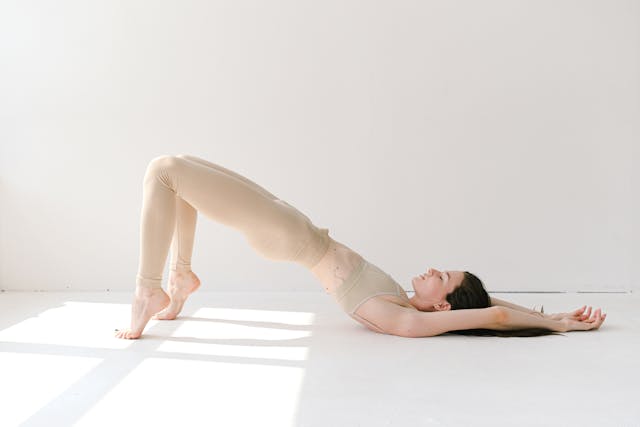
4. Bridge Pose (Setu Bandhasana)
Bridge Pose stretches the chest, neck, and spine. It improves the hamstrings, buttocks, and back.
Steps:
- Lie on your back, place your feet flat on the floor and bend your knees.
- Place your arms at your sides, palms facing down.
- As you raise your hips towards the ceiling, firmly plant your feet.
- Clasp your hands under your back and straighten your arms.
- Hold the pose for several breaths.
Benefits:
- Stretches the chest, neck, and spine.
- Strengthens the back and legs.
- Improves circulation.
5. Cat-Cow Pose (Marjaryasana-Bitilasana)
Cat-Cow Pose increases the flexibility of the spine and warms up the back muscles.
Steps:
- Start on your hands and knees, placing your knees behind your hips and your wrists squarely beneath your shoulders.
- Taking a deep breath, raise your head and tailbone by extending your back (Cow Pose).
- Exhale and round your spine, tucking your chin and tailbone (Cat Pose).
- Continue to alternate between Cow Pose and Cat Pose with each breath.
Benefits:
- Increases flexibility of the spine.
- Stretches the back and neck.
- Improves posture and balance.
6. Butterfly Pose (Baddha Konasana)
Butterfly Pose opens the hips and stretches the inner thighs, groins, and knees. It is also known to stimulate the abdominal organs and improve circulation.
Steps:
- Sit on the floor with your legs extended.
- Bring the toes of your feet together and bend your knees.
- Gently push your knees towards the floor while using your hands to hold your feet.
- Hold the pose for several breaths.
Benefits:
- Opens the hips.
- Stretches the inner thighs and groins.
- Improves flexibility in the knees and hips.
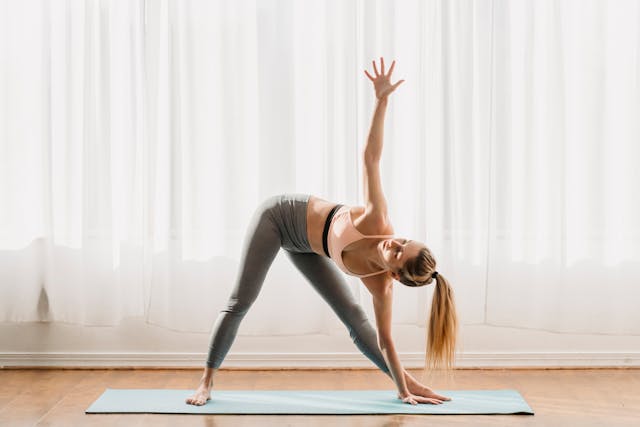
7. Triangle Pose (Trikonasana)
Triangle Pose stretches the legs, hips, and spine. It also opens the chest and shoulders, improving overall flexibility.
Steps:
- Place your feet three to four feet apart as you stand.
- Rotate your left foot slightly in and your right foot out 90 degrees.
- Stretch your arms out to the sides and raise them to shoulder height.
- Reach your right hand down to your shin or the floor and extend your left arm toward the ceiling.
- After a few breaths, hold the position for both sides, then swap.
Benefits:
- Stretches the legs, hips, and spine.
- Opens the chest and shoulders.
- Improves balance and stability.
8. Pigeon Yoga Exercises for Flexibility (Eka Pada Rajakapotasana)
Pigeon Pose (Eka Pada Rajakapotasana) deeply stretches the hip flexors and glutes, relieving tension in the hips and lower back. It also improves hip flexibility and can help alleviate sciatic pain.
Steps:
- Begin in a tabletop position.
- Place your right leg behind your right wrist by bringing it forward.
- Keep your hips square as you extend your left leg back.
- Lower your torso over your right leg and extend your arms forward.
- After a few breaths, hold the position for both sides, then swap.
Benefits:
- Stretches the thighs, groins, and psoas.
- Opens the hips.
- Relieves tension in the lower back.
9. Child’s Pose (Balasana)
Child’s Pose is a gentle stretch for the hips, thighs, and ankles. It is also a resting pose that helps to calm the mind and relieve stress.
Steps:
- Begin on your hands and knees.
- Put your heels back and throw your arms out in front of you.
- Lower your forehead to the floor.
- Hold the pose for several breaths.
Benefits:
- Stretches the hips, thighs, and ankles.
- Calms the mind.
- Relieves stress and fatigue.
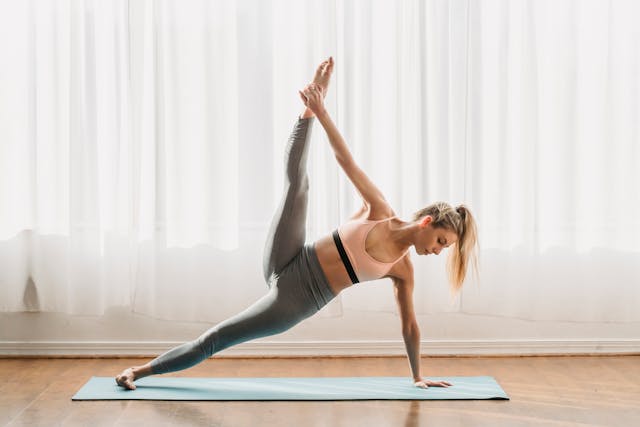
10. Extended Puppy Pose (Uttana Shishosana)
You can perform extended puppy yoga exercises for flexibility where you stretches the spine and shoulders. It also helps to open the chest and improve flexibility in the upper back.
Steps:
- Begin on your hands and knees.
- Lower your chest towards the floor and walk with your hands forward.
- Keep your hips high and your arms extended.
- Hold the pose for several breaths.
Benefits:
- Stretches the spine and shoulders.
- Opens the chest.
- Relieves tension in the upper back.
11. Half Lord of the Fishes Pose (Ardha Matsyendrasana)
Half Lord of the Fishes Pose is a seated twist that stretches the spine, shoulders, and hips. It also stimulates the digestive organs.
Steps:
- Sit on the floor with your legs extended.
- With your foot on the outside of your left thigh, bend your right knee.
- Bend your left knee and bring your left foot to the exterior of your right hip.
- Place your right hand behind you and your left elbow on the outside of your right knee.
- Twist your torso to the right and hold the pose for several breaths.
- Switch sides.
Benefits:
- Stretches the spine, shoulders, and hips.
- Stimulates the digestive organs.
- Improves spinal mobility.
12. Garland Pose (Malasana)
Garland Pose is a deep squat that opens the hips and stretches the ankles, groins, and back.
Steps:
- Stand with your feet slightly wider than hip-width apart.
- To enter a squat, bend your knees and bring your hips down.
- Bring your hands together in front of your chest and press your elbows against your inner knees.
- Hold the pose for several breaths.
Benefits:
- Opens the hips.
- Stretches the ankles and groins.
- Improves balance and concentration.
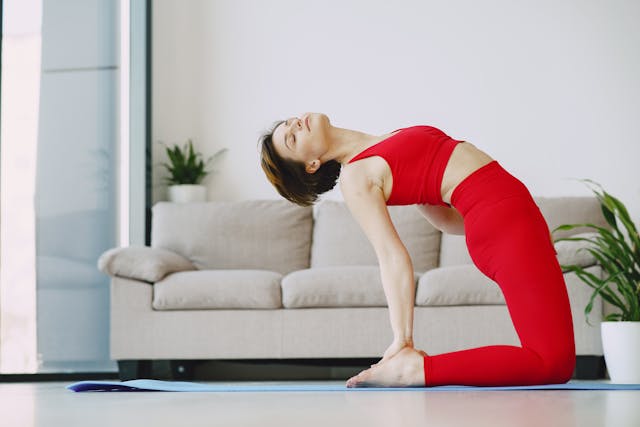
13. Camel Yoga Exercises for Flexibility (Ustrasana)
Camel Pose is a backbend that stretches the entire front of the body, including the chest, abdomen, and quadriceps. It also strengthens the back muscles.
Steps:
- Bowed with your thighs parallel to the floor and your knees hip-width apart.
- Place your hands on your lower back with fingers pointing down for support.
- Inhale, lift your chest, and gently lean back, pushing your hips forward.
- Reach your hands back to grasp your heels, keeping your hips over your knees.
- Lift your chest and gently arch your back, gazing upward.
- Hold the pose for several breaths, then release by slowly coming back up.
Benefits:
- Stretches the chest, abdomen, and quadriceps.
- Strengthens the back muscles.
- Improves posture.
14. Reclining Hand-to-Big-Toe Pose (Supta Padangusthasana)
This pose stretches the hamstrings, calves, and hips. It also helps to relieve lower back pain.
Steps:
- Lie on your back with your legs extended.
- Raise your right leg and place your right hand on your big toe.
- Maintain your left leg stretched on the ground.
- After a few breaths, hold the position for both sides, then switch.
Benefits:
- Stretches the hamstrings, calves, and hips.
- Relieves lower back pain.
- Improves flexibility in the legs.
Cow Face Pose (Gomukhasana)
You can use cow face pose (Gomukhasana) yoga exercises for flexibility that provides a deep stretch for the shoulders, chest, hips, and ankles. It is known for its ability to improve flexibility and release tension in these areas.
Steps:
- With your legs out towards of you, make a seat on the floor.
- Place your right foot behind your left buttock and bend your right knee.
- Bend your left knee and stack your left leg on top of your right leg, bringing your left foot to the outside of your right hip. Your knees should be stacked on top of each other as much as possible.
- Sit up tall with your spine straight.
- Raise your right arm overhead and bend the elbow, reaching your hand down your back.
- Bring your left arm behind your back and bend the elbow, reaching up to clasp your right hand. If your hands do not meet, use a strap or towel to bridge the gap between your hands.
- Once your hands are clasped or connected by a strap, gently draw your right elbow towards the sky and your left elbow towards the floor.
- Keep your head and neck in a neutral position, or slightly lift your chin to deepen the shoulder stretch.
- Breathe deeply and hold the pose for 30 seconds to 1 minute.
Benefits :
- Provides an excellent stretch for the shoulders, helping to release tightness and improve flexibility in the shoulder joints.
- This pose deeply stretches the hips, which can be beneficial for those who sit for long periods or have tight hip flexors.
- By stretching the shoulders and opening the chest, Gomukhasana encourages better posture and alignment of the spine.
